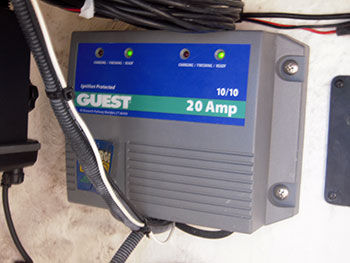Even though spring boating season is around the corner and boaters will be using their boats more frequently, battery chargers are needed to maintain and condition a battery. A well maintained battery will help you get your money’s worth. A battery’s life span can be greatly shortened, when the battery charge drops below 50%.
Today’s new technology, microprocessor controlled chargers, charge according to the style of the battery and battery stage. These chargers are called smart chargers. They interact with batteries by regulating both voltage and amperage through each of the battery stages. The battery will be charged according to the life cycle of the battery (older chargers charge batteries at a constant rate).
Another feature is the battery type selector switch, which allows you to charge your battery according to the type of battery. Different types of batteries have different charging cycles. The three most common types on powerboats are wet cell (flood), gel cell, or AGM batteries.
Smart chargers also sense a battery’s varying temperature to help set the proper charger rate (amp), because a battery performance is affected by its temperature. This feature is called temperature compensation. Companies use different methods of sensing the temperature. One that is commonly used is the automatic temperature compensation with a built in sensor on the charger. The better chargers use a sensor to read the temperature at the battery. See below for an illustration of a Smart Charger.
How many amp hours (charge rate) should I use to charge my batteries? First, take the amp hour rating of the battery and divided by the charger rating (amp), and then add 10% of the quotient for extra time to top off the battery. This will give you the charge time. Keep in mind that a low amp draw and longer charging time penetrates the battery deeper.
There are many other features in selecting a battery charger, just to mention a few: water-proof to protect from the elements, shock/resistant construction, short circuit/reverse polarity protects the charger of improper connection, input voltage115/230 for domestic or international systems, output voltage for 12, 24 or 36 systems, LED lights indicating each battery’s state of charge and multiple banks to charge multiple batteries simultaneously. Boats with more than three batteries may have to purchase two chargers with multiple banks, in order to charge each battery directly. The four bank type chargers are not as popular.
So, next time you are considering purchasing a charger, remember to consider the following: Smart charger features – capable to charge the different types of batteries at their different cycles, equal banks per battery (direct charging), and some of the other features mentioned above to suit your boating needs.
If you have any questions, then contact us at www.jaoutboardservice.com or call us at 786-251-4002.
Happy Boating,
Jorge Alberto
JA Outboard Service
786-251-4002




